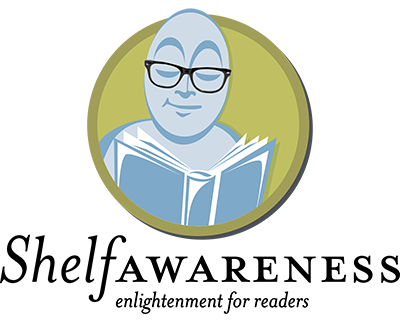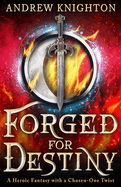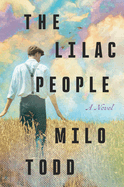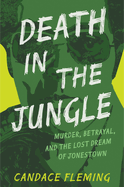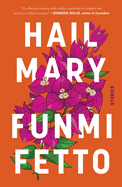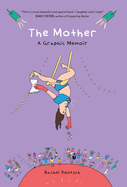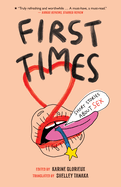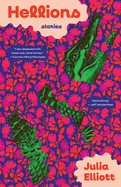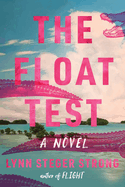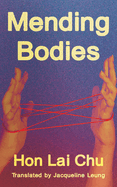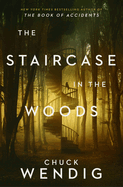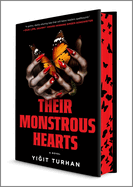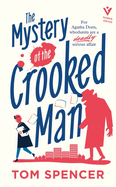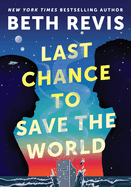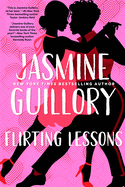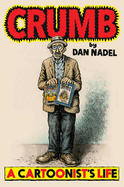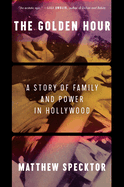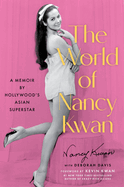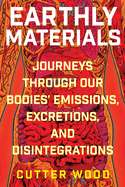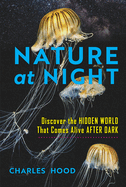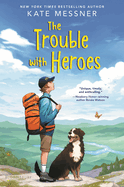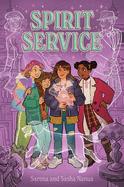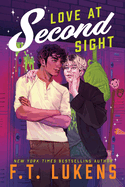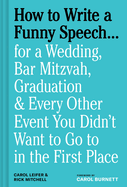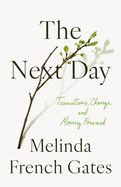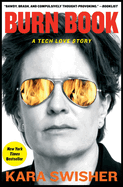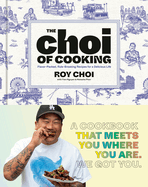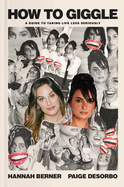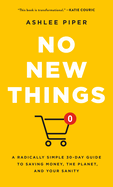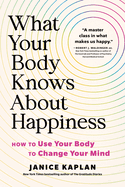Friday, May 2, 2025
This week's issue is brimming with satisfying reading recommendations! Andrew Knighton crafts "a fresh take on the reluctant hero" in Forged for Destiny, turning ideas of valor and villainy upside down in a morally complex fantasy world. Meanwhile, in The Lilac People, novelist Milo Todd reaches into the "nearly lost history of trans people in the Holocaust" to tell a "heartbreaking" story of love, friendship, hope, and survival. And The Mother by graphic novelist Rachel Deutsch is a "balm to new parents" that's "blisteringly honest." Plus, for teen readers, Candace Fleming's Death in the Jungle conveys "with the tension of a thriller" the devastating details about the infamous Jim Jones while recognizing the humanity of his victims in the People's Temple.
And in The Writer's Life, novelist Kevin Nguyen discusses the book that helped him understand the current political moment, offers a cunning pro-tip on how to fake reading nearly anything, and provides an antidote for getting you out of a reading funk.
The Lilac People
by Milo Todd
With The Lilac People, Milo Todd delves into the nearly lost history of trans people in the Holocaust. Integrating imagined characters with historical research, Todd's novel brings humanity and specificity to atrocities that are still being uncovered. The heartbreaking result honors love and friendship, and ends with hope for one built family of survivors.
The opening pages find Bertie on the outskirts of the German city of Ulm in 1945. He has ridden out the war with his partner, Sofie, "on a little farm that was not theirs," growing vegetables, raising chickens. Then, weeks after the news that the Allies have freed camp prisoners, Bertie finds a young man in the garden, dressed in rags from the camp and barely alive. "[The Allies] sent all the pink triangles to jail. And all the black triangles that qualified the same," he tells Bertie. He wears a black triangle. He is a trans man--like Bertie.
Karl's appearance takes Bertie back to 1932 Berlin, where Bertie assists Dr. Magnus Hirschfeld at the Institute for Sexual Science and is a member of a vibrant queer and trans community, with a tight-knit group of friends that is lost on the Night of the Long Knives. Karl's existence brings hope, guilt, and memory. To save Karl and themselves, Bertie and Sofie must leave the farm's relative safety.
The Lilac People is emotionally wrenching, but also lovely in its details, the humanity of its characters, and the resilience and hope at its end, when a fresh start seems possible. Todd has made an enormous contribution to historical fiction with his own research and this beautiful, touching narrative. --Julia Kastner, blogger at pagesofjulia
Discover: A trans man survives with a small chosen family, from Berlin's lively queer scene in 1932 through the Holocaust and the Allies' hostility, in this moving historical novel.
Hail Mary
by Funmi Fetto
Funmi Fetto, style editor for British Vogue, offers her first work of fiction with Hail Mary, an electrifying nine-story collection centering women on the move, some toward freedom, others toward disaster, others caught facing dead ends. Fetto opens with "2 Samuel 6:14," about a pastor's wife who finally plans her escape from heinous abuse; the cleverly chosen verse, "And David danced before the LORD with all his might," provides aspirational inspiration.
Other women are not so lucky, fleeing one bad situation into another, possibly facing entrapment: in the titular "Hail, Mary," a young woman leaves her young son in Nigeria for exhausting failures in London; in "Underneath the Mango Tree," a wife hoping to remedy the couple's childlessness potentially destroys the marriage; in "Trip," a newly orphaned girl is unknowingly sent from Nigeria into servitude in England; in "Housegirl," a girl survives incest only to serve her rapist employer. Fetto thoughtfully, thankfully balances victimization with hard-won self-determination, notably rewarding in "Homecoming," about a new widow who reclaims her ancestral Nigerian food, culture, and country after her white British husband's death.
Perhaps influenced by her notable journalist background, Fetto writes with a pointed directness and clarity. Her fiction deftly highlights ubiquitous challenges to women--particularly physical, psychological, sexual abuse--unembellished, unfettered by judgment: "Escape was futile" signals rape; "you can't eat love" denotes realistic marital expectations; "she threw herself out through the doors" reveals suicide. Despite Fetto's specific geographies here, a character's declaration, "I want to start afresh. On my own," proves an empathic cri de coeur with universal resonance. --Terry Hong
Discover: Funmi Fetto's magnetic first story collection, Hail Mary, features nine determined women struggling to escape familial and societal expectations, with results both devastating and empowered.
Hellions
by Julia Elliott
The talented Julia Elliott alchemizes a mix of southern gothic horror and folktale, creating her own muggy, wild atmospheres in Hellions. In 11 stories, Elliott (The New and Improved Romie Futch; The Wilds) uses her gift for visceral description in various situations; for instance, an abbot "glistens like a broiled ham," a nun's "soul rejoices like a bird flitting from a dark hut, out into summer air," and in "Erl King," college roommates share "mutual longing" that "[fills] the room like a swarm of moths."
Settings include convents, swamps, the aforementioned college campus, cabins, family homes, and more. Elliott is careful never to compose an inert backdrop, and each is thrumming with a vitality that can threaten and comfort alike. In "The Mothers," two children from the mountain upend a group of women and their children at an art colony outside Asheville, N.C. Under their influence, the children, a collective who often appear in animal masks, embark on uncanny pursuits such as climbing to treetops and "yodeling intricate harmonies that stun the mothers." They ultimately blend nature and art by creating eerie pupae, ostensibly as an art project. In "Flying," told in second person, a man embarks on a strange sojourn to visit the forest witch, and complications abound. Animals proliferate this collection, both literally and figuratively: tree frogs bark, insects shriek, and mourning doves get their necks snapped, while people wheedle like dogs, stand like meerkats, and grin like wolves. These are adult fairy tales at their finest. --Nina Semczuk, writer, editor, and illustrator
Discover: Julia Elliott's Hellions is a fantastically imagined blend of southern gothic, folktale, horror, and more.
The Story of a Single Woman
by Chiyo Uno, transl. by Rebecca Copeland
The pioneering Japanese writer Chiyo Uno (1897-1996) gained literary fame by mining her highly unconventional life; she became a published writer in 1921 after winning first prize for a short story submission to a newspaper contest. Her 1933 Confessions of Love remains a celebrated classic. The Story of a Single Woman, originally published in 1972 and translated in 1992 by author/critic Rebecca Copeland, appears in a handsome new edition, enthralling readers with Uno's unabashed candor and exhilarating independence.
Kazue is Uno's stand-in, the oldest child in a family "of substantial means." She's raised by her father's second and considerably younger wife, whom she will always consider her "mother." Witnessing her dissolute father and her long-suffering mother makes her eschew the very concept of marriage. At 13, having been betrothed to her first cousin, she lives briefly with her aunt, but any further union gets cancelled when she returns home in time for her father's death. By the age of 17, she decides "she would never marry," but that doesn't stop her from having multiple love affairs. Over the next decades, her liaisons prove complicated or fleeting, devoted or merely convenient, providing fodder for her writing life.
Uno notably composes in hybrid third- and first-person viewpoints. Kazue opens as a septuagenarian who recalls her untraditional past in third-person, but Kazue also occasionally inserts her older self over her younger as a questioning observer, cleverly creating distance with phrases like "I suppose," "it would seem," and "perhaps." Still undeniably timeless, The Story of a Single Woman presents an immutable portrait of a courageous young woman who chooses to live with forthright authenticity. --Terry Hong
Discover: The Story of a Single Woman presents an unflinching portrait of a woman unafraid to eschew traditions and escape social mores in early 20th-century Japan.
The Float Test
by Lynn Steger Strong
In Lynn Steger Strong's The Float Test, someone is always diving under a wave, peeling off a shirt for a quick swim, or sitting poolside with their feet in the water. Characters are stretching long strokes out past the break or aiming for a distant sandbar. Rarely are they floating--"None of us had had the patience, the ability, to lie back and be still like that." "Us" refers to Kenner siblings Jenn, Fred (short for Winnifred), Jude (short for Judy), and George, around whom Strong (Hold Still; Want) builds a blistering novel about Florida and family dynamics, evoking heat and uncertainty as well as the comforts of home, no matter how long you've been away.
The Float Test explores the unhappy complications among these four adult siblings who are reckoning with their past and their possibilities after the untimely death of their mother. Jenn, the eldest and unofficial spokesperson for the group, delivers the eulogy at their mother's funeral: "She said a bunch of stuff about Mom that was at least half made-up." Strong tangles with this idea of partial truths or, in the case of writer Fred, truth masquerading as fiction. The novel gives readers the most access to Fred, but it is voiced by Jude. There has been a rift between the middle sisters, a betrayal obscured until nearly the end of the novel, and their physical estrangement makes for a provocative contrast with the narrative's intimacy. With so many cracks in this complicated family's facade, readers will wonder if they will be able to weather the storm. --Sara Beth West, freelance reviewer and librarian
Discover: This blistering novel explores the complications within one unhappy family as four adult siblings reckon with their past and their possibilities following the untimely death of their mother.
Mending Bodies
by Lai Chu Hon, transl. by Jacqueline Leung
If walking in someone else's shoes is meant to encourage empathy, Hong Kong writer Hon Lai Chu exaggerates the adage, medically conjoining bodies in her disturbingly consuming dystopic novel, Mending Bodies. Writer Jacqueline Leung, also from Hong Kong, seamlessly enables English access in her first full-length translation.
The recent Conjoinment Act legislates how individuals are to merge their bodies into surgically bound pairs. A psychologist encourages conjoinment as the antidote to society's "state of crisis": "The obsolete institution of marriage, racial conflict, wealth discrepancy, the many contrived wars--they all came from our inability to fill the existential lack we were born with as individuals." Only by being stitched together is "true fulfillment" possible. Environmentalists are also supportive: "A conjoined couple will shower, eat, and travel together, consuming less gas and water than if they were single." The unnamed narrator, focusing on conjoinment as her dissertation topic, considers multiple ways of being--alone, with a roommate, with family, as a conjoined couple. What she eventually decides for her own future will engender irreversible consequences.
Hon's strange and creepy tale is infused with plenty of body horror--and, perhaps, unintentionally absurd logistics (how might two bodies attached at the chest use a toilet?). Her sparse writing suggests more than it reveals on the page, cleverly encouraging extraneous imaginative scenarios. Interwoven with the narrator's existential queries and dilemmas are excerpts from her dissertation-in-progress, with sources and subjects so convincing as to require Google breaks between chapters; the "case studies" prove particularly provocative. Mending Bodies deftly challenges the future of individual autonomy. --Terry Hong
Discover: Hong Kong author Hon Lai Chu's Mending Bodies deftly, provocatively explores the disturbing, convincing possibility of surgically conjoining pairs of human beings.
Mystery & Thriller
The Staircase in the Woods
by Chuck Wendig
The singular Chuck Wendig (Black River Orchard; Blackbirds; Zeroes) brings his trademark blend of humor, profanity, and shrewd observation to the weirdly charismatic The Staircase in the Woods. Chilling, disturbing, and deliciously entertaining, this horror novel stars a group of one-time best friends who reunite as adults across a chasm of time and trauma. Nick is as abrasive as ever, but at least he gets them all back together again. Hamish has traded in his Birkenstocks, jam bands, and extra weight for fitness, church, and family. Lore (formerly Lauren) has achieved professional success, but only through an increasingly belligerent go-it-alone approach. Owen (aka Nailbiter) is barely surviving his mental health woes. And Matty, once their golden boy, hasn't been seen since that day in the woods in 1998. Five teens went camping, four came back out again. Now, more than 20 years later, they have a chance to try to find out what went wrong--or lose themselves like Matty did.
Four dysfunctional adults walk into a different set of woods, fighting among themselves and against their own demons, and enter a sinister otherworld that may have consumed their friend. Wendig's narrative emphasizes the strengths and failures of friendship, and the difficulties of both childhood and adulthood. His snark is obscenity laden but also earnest in its compassion. The Staircase in the Woods deals in torture, violence, and abuse, especially within families, portraying how connection to place and the importance of home can cause at least as much pain as comfort. The result is haunting and unforgettable. --Julia Kastner, blogger at pagesofjulia
Discover: Former best friends reenter a scene of horror in this clever, terrifying novel about the dangers that lurk in friendships, home, and the self.
The Impossible Thing
by Belinda Bauer
Who knew bird-egg trafficking would make a fascinating topic for a crime novel? Apparently Belinda Bauer did, as her first release since 2021's Exit is an extraordinary, funny story about people who steal and deal rare bird eggs.
The Impossible Thing follows two timelines 100 years apart. In the 1920s, little Celie Sheppard, a poor six-year-old child living on a farm, decides she wants omelets. Since her single mom can barely afford rent and food, Celie asks their farmhand to dangle her dangerously off a cliff so she can grab eggs freshly laid by guillemots perched under the overhang. When she comes up with a bright red egg--something the world has never seen--a broker pays her handsomely for it so he can sell it to one of his egg-collecting clients.
In the present, Patrick Fort (the winning protagonist from Bauer's excellent Rubbernecker) finds his friend Weird Nick and Weird Nick's mom tied up in their house after a robbery. The only item stolen was an egg in a fancy wooden box Weird Nick had found in the attic. As the chapters unfold, the links between Celie, Patrick, and Weird Nick become clear.
Bauer (The Beautiful Dead; Snap) has an inimitable, captivating voice that pivots between breathtaking sadness and utter hilarity. For instance, because Celie's mother struggles to pay rent every month, the little girl believes the landlord is named "Mr. Bastard--first name, That." Celie and Patrick are scrappy, endearing protagonists, and falling in love with them is a very possible thing. --Elyse Dinh-McCrillis, reviewer and freelance editor at The Edit Ninja
Discover: Fantastic protagonists propel Belinda Bauer's moving and witty crime novel The Impossible Thing, set in the world of bird-egg collecting.
Their Monstrous Hearts
by Yigit Turhan
Enthralled readers may never look at a swarm of butterflies the same way again after navigating the dark terrors of Their Monstrous Hearts, the English debut by Yigit Turhan, a Turkish author living in Italy. This startling gothic horror novel's dual timeline follows 20-year-old Riccardo, a destitute aspiring novelist in Paris who's suffering from writer's block, on his spellbinding trajectory to a desolate estate in Milan.
Riccardo has no idea what to expect after a stranger with bad burn marks, Maurizio, arrives at his apartment with a compelling message from Riccardo's grandmother Perihan, who willed him her property along with a butterfly collection. Although reluctant to make the trip for her funeral, he has no choice but to use the one-way train ticket to Milan after he can't meet his rent and the power is shut off. He is greeted by Licia, his grandmother's maid, who "appeared unchanged." On the other hand, the villa is in disrepair, including a greenhouse, "glass windows smeared with dirt and choked by intertwining, lifeless branches of plants long gone." Riccardo discovers his grandmother's handwritten journal, which is the novel's second narrative and becomes the core of their intertwined destinies.
Unsettling scenarios include an elixir of resurrection, a long-ago deadly circus fire, and tales of a Forest of Immortality near Mexico. The novel builds to a crescendo of grotesquerie and Jungian transformation. Nothing short of a collaboration between Vladimir Nabokov, Alfred Hitchcock, and Stephen King could have produced anything more luxuriantly atmospheric or ultimately disturbing--in a good way. --Robert Allen Papinchak, freelance book critic
Discover: Readers will shiver at the frightful, unforgettable excursion into sheer, exhilarating terror of Yigit Turhan's Their Monstrous Hearts.
The Mystery of the Crooked Man
by Tom Spencer
The world of crime fiction has a marvelous new misanthrope: Agatha Dorn, who narrates Tom Spencer's soot-black comedy of a first novel, The Mystery of the Crooked Man, a top-notch tale of blackmail, corporate greed, and extreme grammar policing.
Agatha, an assistant curator at London's Neele Archive, is equally hard charging with her grammar rules and her alcohol consumption. Things are looking up for Agatha when, while rooting around in the archive, she unearths a draft of an unpublished novella by Gladden Green, a foremost golden-age mystery writer. Agatha smells an opportunity: she informs Green's grandson, chairman of Gladden Green, Ltd., that she'll shred the novella if he doesn't give her a cut of the royalties when the book is published. He acquiesces, but everything else goes wonky for Agatha, what with the fallout from her ex-girlfriend's suicide, Agatha's boss's unexplained disappearance, an avaricious company's stepped-up effort to gobble up the Neele Archive's land, and her niggling doubt regarding the Green manuscript's authenticity.
That Agatha feels forced to play detective is delicious given her lack of respect for the mystery genre--Green's novella, she will have it known, "wasn't literature, of course." But a protagonist's hilariously extravagant condescension can take a crime novel only so far; happily, Spencer has carefully mapped out his old-school-style mystery, capping it off with a gobsmacking twist. Readers would do well to pick up the brainily escapist The Mystery of the Crooked Man, Agatha's opinion that "relaxation is not a legitimate reason to read a novel" notwithstanding. --Nell Beram, author and freelance writer
Discover: Both an old-school-style mystery and a soot-black comedy, this top-notch first novel centers on an assistant curator at a London archive who turns to blackmail after she unearths a lost manuscript.
Science Fiction & Fantasy
Forged for Destiny: A Heroic Fantasy with a Chosen-One Twist
by Andrew Knighton
A fresh take on the reluctant hero trope, Andrew Knighton's Forged for Destiny, the first volume in a planned trilogy, is brimming with complex characters and shades of morality.
Raul knows that Prisca and Valens aren't his birth parents, but he is happy learning strength and fighting from Valens and studying history with Prisca. After Raul stumbles across a prophecy involving a symbol that matches his birthmark, Prisca tells him he is the son of the queen who died two decades earlier when the Empire of Estis fell to invaders from Dunholm. The birthmark means he is destined to save his country from the invaders, who rule with cruelty and suppress reading and magic. But while Raul wants to save innocent people, he doesn't want to participate in the killing and destruction that Prisca insists is necessary. Readers know something Raul doesn't, though: he was an orphan, chosen at random and branded by Prisca with the prophecy's symbol in a plan to regain control of Estis. But the more he learns of reality, the more he doubts his ma's divining and his destiny as a hero.
Moving between several characters' perspectives, Forged for Destiny balances intense scenes of fighting and violence with equally intense moments of quiet reflection. Knighton turns the usual archetypes of high fantasy on their heads, questioning the very definition of heroism and villainy in a thrilling novel about a young man's growing understanding of political and moral complexity. --Dainy Bernstein, freelance reviewer
Discover: In this fresh take on the reluctant hero trope, Raul discovers he is destined for heroism, but learning what heroism truly entails makes him question everything he thought he knew about good and evil.
Last Chance to Save the World
by Beth Revis
Ada Lamarr, sarcastic galaxy-crossing smuggler, and rule-following government officer Rian White return for one last adventure in the fast-paced, snarky conclusion to Beth Revis's Chaotic Orbits novella trilogy, aptly titled Last Chance to Save the World. In Full Speed to a Crash Landing and How to Steal a Galaxy, Revis sent Ada and Rian on a collision course, to highly entertaining effect. Now, they have a tight window of time to return to Earth and sabotage a billionaire's plot to release climate-cleaning nanobots infected with malware. But first, they've got to confound multiple security systems--and visit Ada's mother.
Revis's narrative zips along like one of Ada's spaceships, bouncing between Ada's irreverent inner monologue and Rian's curt memos to his team, which are sprinkled with wry, telling footnotes. They're forced to adapt on the fly as security protocols and family ties frustrate their original plans, all while acknowledging that their brief partnership is nearing its end. As Revis turns up the will-they-won't-they heat, she also incorporates pointed commentary on technocrats who are convinced of their right to rule, plus an unexpectedly poignant mother-daughter story line (and a few insights on pigeons). Ada and Rian dodge sophisticated technology traps and the messy feelings in their own hearts, but they also must replace the nanobots' code without getting caught--or Earth may be doomed. With a high-octane blend of chaos and romance, Revis's novella is great fun for fans of heists, space operas, and saucy star-crossed lovers. --Katie Noah Gibson, blogger at Cakes, Tea and Dreams
Discover: Beth Revis delivers a high-octane conclusion to her fast-paced trilogy of space novellas featuring a snarky mercenary and a buttoned-up government agent.
Romance
Flirting Lessons
by Jasmine Guillory
Jasmine Guillory (The Proposal; Drunk on Love) returns to California's Napa Valley in Flirting Lessons. Avery is a reserved and successful event planner, just out of a relationship with the wrong person when she encounters Taylor, an outgoing flirt who never seems to have the same girlfriend for more than a few months. Taylor happens to be looking for a distraction from her own love life, so she offers to help Avery learn to flirt, especially with women. As the pair explores queer events and Avery begins to navigate the queer community, Taylor soon realizes she wants Avery--and not just for a quick tryst.
As in all of Guillory's romances, the central couple is surrounded by a diverse and well-depicted community of friends that enhance and propel the plot. Guillory deftly develops her characters and realistically portrays how relationships change as life moves forward, as well as how Avery finds herself after her breakup. Of course, she delivers on the spice as well, which serves as a means to deepen the characters and their relationship with each other. Readers of Drunk on Love will appreciate appearances by its characters here, but Flirting Lessons can be enjoyed on its own.
Guillory continues to skillfully depict the healthy adult relationships that readers love. She is not shy about illustrating her characters' flaws and includes scenes in which they care for each other and have honest relationship talks that feel true to life. Flirting Lessons is a sweet and sexy escape. --Alyssa Parssinen, freelance review and former bookseller
Discover: Jasmine Guillory returns to California's Napa Valley with Flirting Lessons, a delightfully hot and heartfelt queer romance.
Graphic Books
The Mother: A Graphic Memoir
by Rachel Deutsch
In her debut, The Mother: A Graphic Memoir, Rachel Deutsch pays blisteringly honest and acidly funny homage to the temporary hell that is brand-new parenting.
"I'd always wanted a baby," Deutsch writes; she figures "they would grow to only hate me a little." But when Deutsch finds herself pregnant, she worries: "What if I don't relate to being a mom? What if I become my mother?" After her daughter is born, Deutsch feels overwhelmed, and her relationship with her partner, Marc, suffers. They spar over who can legitimately claim to be more exhausted--"the winner was the one who could prove the other had more sleep." Deutsch and Marc go to couples therapy, and she sees a therapist independently to discuss her childhood, reinforcing readers' understanding that the book's title has two referents.
The Mother should be a balm to new parents who find themselves utterly upended by the initially mixed blessing that is the blessed event. Like Deutsch's text, her art has a take-me-as-I-am candor. She works with a sure hand and fills her fine lines with flat, grounding colors, and she packs big observations into even her modest-scale panels; one presents a side view of a bathtub with a mountainous dome of skin poking out: "My [pregnant] belly was a giant meatball in a tiny bowl of soup." And Deutsch surely wins the prize for best capturing the absurd-seeming proportions of a nursing mother's breasts, which in The Mother can take on the dimensions of swimming pool noodles. --Nell Beram, author and freelance writer
Discover: Fueled by take-me-as-I-am candor, this graphic novel is a acidly funny homage to the temporary hell that is brand-new parenting.
Biography & Memoir
Crumb: A Cartoonist's Life
by Dan Nadel
Curator and author Dan Nadel explores cartooning legend Robert Crumb in all his glory and depravity in Crumb: A Cartoonist's Life. Nadel, author of several books about cartoonists and artists, has created a nearly 500-page volume that's exceedingly thorough. In the foreword, Nadel explains, "Robert imposed just one condition on this book: that I be honest about his faults, look closely at his compulsions, and examine the racially and sexually charged aspects of his work." And that Nadel does, pulling from Crumb's personal archives, which include "correspondence, diaries, sketchbooks, and notes," as well as interviews with Crumb and his friends and colleagues, plus plenty of b&w and color illustrations.
Nadel is a lively writer who captures not only the material conditions of Crumb's childhood but also the texture of growing up in a tumultuous, post-World War II household. Physical abuse and suicidal ideation stalked Crumb's family, but Nadel also recounts other sadnesses and disappointments. For instance, when Crumb was eight years old, he received a $25 war bond for winning a poster design contest; his mother asked to borrow the money and never repaid him. After grounding readers in Crumb's early years, which include his crucial discovery of Mad magazine, Nadel moves on to all the twists of life and career Crumb experiences after leaving home.
Along with copious historical and biographical information, Nadel includes details cartoonists will inhale, such as how Crumb first came to use a Koh-I-Noor size 00 Rapidograph and developed his "own vertical hatching technique." Crumb is an enjoyable, all-encompassing read. --Nina Semczuk, writer, editor, and illustrator
Discover: Crumb: A Cartoonist's Life is a tremendously enjoyable read for anyone seeking an exceedingly thorough examination of the life and career of cartooning legend Robert Crumb.
The Golden Hour: A Story of Family and Power in Hollywood
by Matthew Specktor
Anyone under the impression that a Hollywood upbringing is nothing but glamour and red carpets will find a sobering reality check in Matthew Specktor's The Golden Hour, a well-written memoir that is both coruscating toward the bare-knuckle boxing that is the film industry and warmhearted toward members of his family. Foremost among the latter is Specktor's father, Fred, a UCLA grad who wanted to become a talent agent because he thought the work was "admirable." He became factotum to Lew Wasserman, president of Music Corporation of America (MCA) and "the most powerful person in the film colony." Wasserman often chewed Fred out for various transgressions, such as failing to deliver a script on time to Gregory Peck. Soon, however, Fred became a high-powered agent at Creative Artists Agency, "the man who tells the studio what to do," with clients such as Marlon Brando and Robert De Niro.
Imagine being the child of a guy like that. Readers won't have to, as Specktor describes what his L.A. story was like, including the time at age three when he and his dad bumped into a promising up-and-comer named Jack Nicholson; his mother, Katherine, and her experiences with alcohol dependency and fledgling attempts at screenwriting; and Matthew's own struggles with addiction (he listened to Led Zeppelin while on Quaaludes in his bedroom at age 10); and his high-profile office jobs within the industry. The jobs are only intermittently glamorous, but this memoir never fails to enthrall. --Michael Magras, freelance book reviewer
Discover: Matthew Specktor's enthralling memoir of growing up the son of a Hollywood talent agent is both a coruscating look at the film industry and a sympathetic portrait of his family.
The World of Nancy Kwan: A Memoir by Hollywood's Asian Superstar
by Nancy Kwan with Deborah Davis
Before Nancy Kwan was cast in 1960's The World of Suzie Wong, Hollywood routinely had Caucasian actors in yellowface playing Asian characters. Kwan writes of being at the vanguard of change in the engaging and sobering The World of Nancy Kwan: A Memoir by Hollywood's Asian Superstar.
Kwan was born in Hong Kong in 1939 to a Cambridge-educated Chinese father and an English mother. Kwan's first love was dance, and after graduating from an English boarding school, she attended London's Royal Ballet School. Back in Hong Kong in 1959, she decided to observe the auditions for the female lead in a Hollywood movie centered on a young Chinese prostitute with whom an American man falls in love. A scout spotted Kwan on the sidelines; she tested for the role and (eventually) won it. After she made the high-profile The World of Suzie Wong, Kwan starred in, among other films, Flower Drum Song, the first Hollywood musical with an almost all-Asian cast.
Like Yunte Huang's Daughter of the Dragon, The World of Nancy Kwan considers the particular difficulties faced by Asian actors in Hollywood; as Kwan puts it, she wanted to play parts that weren't "written for an Asian but for a person." She writes that she turned down a role in 1993's The Joy Luck Club because the producers refused to remove a line that she felt misrepresented The World of Suzie Wong as racist--a decision that may have cost Kwan professionally but reflects a principled life well worth reading about. --Nell Beram, author and freelance writer
Discover: In her engaging and sobering memoir, Nancy Kwan writes of being at the vanguard of change as an Asian actor who began her career during Hollywood's golden age.
Science
Earthly Materials: Journeys Through Our Bodies' Emissions, Excretions, and Disintegrations
by Cutter Wood
Cutter Wood (Love and Death in the Sunshine State) offers a spellbinding collection of facts, observations, and musings in Earthly Materials: Journeys Through Our Bodies' Emissions, Excretions, and Disintegrations. In 12 chapters that might be termed "essays" and Wood calls "stories," he considers mucus, urine, blood, semen, menses, milk, flatulence, breath, feces, vomit, hair, and tears. While readers will certainly gain new and fascinating scientific knowledge, what makes Earthly Materials so special is storytelling: Wood's compassionate, funny, earnest explorations through unexpected subject matters adjacent to bodily fluids.
At a lab at the Massachusetts Institute of Technology, he meets impassioned graduate students and views beautiful stellar-like magnifications of mucus, which resemble Hubble Telescope photographs. He discusses the political and financial implications of donating blood and delves into the discomfiting r/NoFap Reddit forum. In the absorbing true-crime case of Formula Mom, a Florida woman is investigated and sentenced to prison for creating a large-scale business that bought and sold infant formula.
Tongue-in-cheek, Wood describes the flatulence customs and practices of the preadolescent male in the Commonwealth of Pennsylvania. To explore vomit, he joins the Soul Quest Ayahuasca Church of Mother Earth and takes its sacrament. These experiences and studies often yield hilarity in Wood's expert prose: dryly witty, comically verbose, and poignant. Wood finishes with the inexplicable tears of a Wimbledon finalist, in this thought-provoking philosophical study that exemplifies human interconnectedness through the rather surprising lens of bodily fluids and expulsions. Earthly Materials will change the way readers think about the mundane in unanticipated and transcendent ways. --Julia Kastner, blogger at pagesofjulia
Discover: This weird, wonderful exploration considers the social, cultural, and political implications of bodily emissions as well as their science, but shines brightest in its empathetic storytelling.
Nature & Environment
Nature at Night : Discover the Hidden World that Comes Alive after Dark
by Charles Hood
Charles Hood (A Salad Only the Devil Would Eat) brings the nighttime world alive in Nature at Night, sharing an irresistible delight for his subject that is informative, entertaining, and captivating.
The introduction covers topics including the mythical equating of night and evil, the benefits of studying nature after dusk, and even an explanation of why night exists on Earth. Setting the tone for the rest of the book, Hood peppers the introduction with comical asides such as a reference to Dean Martin's "That's Amore" when describing humanity's obsession with the moon and the "constant stream of poo" one might encounter when standing underneath a tree filled with a certain species of bat. Subsequent chapters are accompanied by striking photos and delve into various groups of nocturnal animals (owls, moths, certain cats, monkeys, and fireflies) and environments (desert, forest, and ocean). The final chapter contains a case study of the rainforest, to which Hood brings readers along on an expedition via lush descriptions and minute-by-minute narration.
Hood doesn't just explain the lively world of nighttime nature; he also invites readers to experience it for themselves, writing in second-person address and providing occasional tips, too. For instance, readers "might want to wear gloves, and do wash your hands" afterward if they choose to inspect an owl's regurgitated pellet of mouse bones. Hood's obvious enthusiasm for the profuse life of the night is infectious, and his celebration of "the interesting places, the exciting discoveries, the new connections that scientists (and artists and poets) make every day" will brighten every reader's life--and night. --Dainy Bernstein, freelance reviewer
Discover: With striking photos and exciting descriptions, Nature at Night brings the time between sunset and sunrise alive through explorations of its many and varied inhabitants.
Travel Literature
Into the Ice: The Northwest Passage, the Polar Sun, and a 175-Year-Old Mystery
by Mark Synnott
Longtime friends make a dangerous Arctic voyage in Into the Ice: The Northwest Passage, the Polar Sun, and a 175-Year-Old Mystery by Mark Synnott (The Third Pole), which crosses an adrenaline-fueled travelogue with a narrative history of exploration.
Synnott has summited Mount Everest and is known for his work for National Geographic Television, among other outlets. Still, he secretly nursed a lifelong ambition to traverse the Northwest Passage, a route that connects the Atlantic and Pacific Oceans through the Arctic. Synnott's purchase of a fiberglass sailboat he named Polar Sun spurred him to plan a voyage, and his promise to make an attempt at finding the grave of British explorer Sir John Franklin secured funding for the expedition. Franklin's famously ill-fated search for the Northwest Passage in 1845 ended in his death, and his resting place somewhere in the Arctic likely contains logbooks detailing his expedition's last days. Synnott and his small crew faced storms that caused immense waves, prowling polar bears, "ghostly walls of ice," and the strain that grueling conditions can place on even the oldest of friendships.
Synnott blends his research of the history and fate of the Franklin expedition with a 21st-century adventure story that includes bittersweet musings on the effects of global warming on polar ice levels and his impressions of the Inuit, whose understanding of the terrain was ignored by European explorers. This thrill ride of a voyage should please history buffs and armchair travelers alike. --Jaclyn Fulwood, blogger at Infinite Reads
Discover: The crew of a small boat search for a lost expedition's grave site in this thrilling account of a 21st-century voyage through the Northwest Passage.
Children's & Young Adult
Death in the Jungle: Murder, Betrayal, and the Lost Dream of Jonestown
by Candace Fleming
Acclaimed nonfiction author Candace Fleming (Is It Real?: The Loch Ness Monster; The Rise and Fall of Charles Lindbergh) documents with the tension of a thriller the history of an infamous 20th century cult while maintaining a sense of humanity that conveys immense empathy for its victims.
Death in the Jungle is a gripping and disturbing nonfiction narrative about cult leader Jim Jones, the survivors "who lived through their association with [his] organization," and the victims who died under his leadership. The book follows Jones's trajectory from impoverished child to leader of the Peoples Temple religious organization. The temple, which began as a church in Indiana, evolved into a commune, first in California and then in Guyana, where it became known as Jonestown. In 1978, the increasingly "paranoid and cruel" Jones ordered his followers to commit "revolutionary suicide," resulting in the deaths of more than 900 people.
Fleming includes a list of names of Peoples Temple members and goes beyond sensationalized headlines to humanize the individuals in her book, exploring "what caused seemingly 'normal' people to get caught up in something so fanatical?" Fleming describes how cults function and includes harrowing accounts from survivors, explaining why so many people were drawn to the organization and then unable to leave. Fleming also challenges the pervasive understanding of Jones's victims as "brainwashed cultists" who willingly took their own lives: she notes that many adults challenged Jones's orders and that hundreds of children and elderly, "unable to defend themselves," were murdered by temple nurses. Readers drawn to the darkly engrossing subject matter will likely leave Fleming's suspenseful work of nonfiction with a more nuanced understanding of this historic tragedy. --Alanna Felton, freelance reviewer
Discover: Candace Fleming's account of Jim Jones and the People's Temple is a riveting and nuanced nonfiction narrative.
First Times: Short Stories About Sex
by Karine Glorieux, editor, transl. by Shelley Tanaka
Young adults bumble through a variety of often lovely, sometimes awful, regularly awkward sexual firsts--with themselves, with others--in this much-needed collection of boldly honest short stories.
First Times: Short Stories About Sex features nine works of fiction by nine authors (edited by Canadian Karine Glorieux and translated from French by Shelley Tanaka) regarding "first times." The key message is that it is not likely to look, sound, smell, or feel anything like sex in the movies or on the Internet. The reality might smell, as Nicholas Michon writes in "This Ain't Your Grandpa's Pipe," more like "Doritos and chlorine"; sound like embarrassed laughter; or feel uncomfortable and sweaty. Or it can be even better than imagined, though, again, nothing like the movies. As one would-be first-timer says in "My First Time" by Laurence Beaudoin-Masse, "I was assailed with textures, impressions, substances like so many micro-invasions."
The bright, intimate tales are packed with all the massively complicated feelings people can have about sexuality: delight, shame, humor, confusion, frustration, deception, and bliss. The writing is invariably sex positive: "Why do I consider my first kiss to be my 'first time'?... My first kiss was the first time I realized that sexual desire had to be at play--on both sides of that kiss" (Jérémie Larouche, "Rolling a One"). More than anything, the stories offer a wide range of normal experiences, even as the protagonists ask, over and over: Is this normal? Am I normal? The answer, again and again in this marvelous collection, is yes. --Emilie Coulter, freelance writer and editor
Discover: An emotionally resonant, uninhibited collection of stories floods readers with the beautiful message that sexual firsts can be as varied in detail and response as people themselves.
The Trouble with Heroes
by Kate Messner
A seventh grader grieving the death of his father gets offered an unusual deal in the redemptive, cathartic outdoor adventure novel-in-verse The Trouble with Heroes by Kate Messner (Chirp).
Finn Connelly's father, a New York City firefighter turned paramedic, had struggled with PTSD and alcoholism following his experiences on 9/11. He died on the job during the Covid-19 pandemic. The boy's last memory of his dad is a moment during the pandemic when he came home "eyes tired and wild, ambulance double-parked on the street, just for a minute" to see his family. Now Finn has gone viral for the unheroic act of kicking over a headstone--that of a woman nicknamed "Queen of the High Peaks" for her time spent hiking in the Adirondack Mountains and encouraging thousands of others to do so as well. Her daughter offers to waive the vandalism charges if Finn agrees to spend his summer finishing her mother's goal: hiking the 46 High Peaks, this time with her exuberant dog, Seymour. Finn--who isn't even a dog person--faces his task reluctantly, but what starts as a chore turns into a summer of amazing vistas, unexpected mentors, and personal discovery.
Messner blends free verse, haiku, photos from Adirondack overlooks, and cookie recipes in this unforgettable hike through a boy's struggle with grief and the dark side of heroism. Tween and young teen readers who appreciate contemporary fiction or mixed media novels should find plenty to ponder in this emotionally potent narrative that contains more heart-wrenching moments than the Adirondacks have high peaks. --Jaclyn Fulwood, youth services manager, Allen County Public Library
Discover: A seventh grader atones for vandalizing a woman's grave by climbing all 46 Adirondack High Peaks with her dog in this emotional, encouraging adventure novel-in-verse.
Spirit Service
by Sarena Nanua and Sasha Nanua
Author duo and twin sisters Sarana Nanua and Sasha Nanua (Sisters of the Snake) channel the spirit of Ghostbusters in Spirit Service, a spunky paranormal middle-grade novel about a group of tweens who start a small business shepherding souls.
Twelve-year-old Raveena Gill hates that her school cut funding for its arts program--music was her only remaining connection with her recently deceased Grandmama. Raveena and her group of friends, the Fierce Four, are determined to win a school-wide business competition to help fund the program. Their plan changes, though, when all four girls are zapped with supernatural powers by an ancient phone from the local antiques shop. The Fierce Four become Guardians: people who help spirits pass through to the other side. They abandon their previous business plan and start the Spirit Service, helping the residents of their zany town connect with lost loved ones. But the town's ghostly history hides unpleasant secrets and, when Raveena realizes the phone can connect her with Grandmama, she starts to keep a few of her own. But even magic may not be able to fix the rift Raveena creates between herself and her friends.
High stakes and eccentric characters take center stage in Spirit Service, which will likely tickle fans of Anna Meriano's Love Sugar Magic. The emotional turmoil experienced by some ghosts is a bit hyperbolic and occasional asides seemingly aimed at adults may take readers out of the narrative, but Raveena's bubbly voice is perfect for middle-grade readers. Her growth as both an individual and as a friend is sweet and earnest. Readers who love strong friend groups, quirky settings, and scary-sweet spectral figures should enjoy Spirit Service. --Nicole Brinkley, bookseller and writer
Discover: Four friends struggle with the burden of helping ghosts pass on while keeping their own secrets in this zany, spunky middle-grade paranormal novel.
Love at Second Sight
by F.T. Lukens
F.T. Lukens's YA fantasy Love at Second Sight is a mystery that is as soapy as it is thrilling. Queer witches, werewolves, sprites, and other fantastical beings stumble through awkward teen foibles, interrupted by monsters both real and metaphorical.
Cam Reynolds, a "honey blond"-haired 15-year-old, lives in a town where "witches, werewolves, faeries, sprites, and a whole host of supernatural entities" shop at the same grocery stores and attend the same schools as non-paranormal humans. His bestie, Al, has "beautiful brown skin," a "comforting and cozy" cottagecore witchy vibe, and a raven familiar named Lenore; his hunky crush, Latino Mateo, is a werewolf. But Cam is "only human"--he thinks. During a dustup on the first day of school, his latent gifts as a clairvoyant manifest: he sees the brutal murder of a young woman he doesn't recognize. Traumatized, Cam is unsure of this newfound power and what he's meant to do with it. And, since seers are rare, different factions of mystical beings all want a piece of him. Cam, with the help of Al, Mateo, and a new crew of friends, decides to find the killer, save the girl, and stop the future he has seen from becoming reality.
Lukens (Otherworldly) is no stranger to the world of the young, exceptional, and angsty. Lukens's mastery of the adolescent hero's journey is on full display here: though the whodunnit may be the endgame, it's Cam's arc of empowerment through the relationships he solidifies with his friends that fuel the book. A surprisingly substantive treat about surviving in a monstrous world. --Luis G. Rendon, freelance reviewer
Discover: Paranormal teens bumble their way through high school classes, crushes, and potential homicide in this thrilling and soapy YA fantasy.
In the Media
The Writer's Life
Reading with... Kevin Nguyen
 |
|
| photo: Robyn Kanner | |
Kevin Nguyen is a novelist and journalist living in Brooklyn, N.Y. His debut, New Waves, was named one of the best books of the year by NPR, Parade, Kirkus, and others. His second novel, Mỹ Documents (One World), is a most-anticipated book by Rolling Stone, Bookpage, and LitHub. It centers on the paths of four family members and how they diverge drastically when the U.S. government begins detaining Vietnamese Americans. He is a features editor at the Verge and has written for the New York Times, New York magazine, the Atlantic, and more.
Handsell readers your book in 25 words or less:
Mỹ Documents imagines a modern-day echo of Japanese internment and how a family copes with separation and the line between survival and selfishness.
On your nightstand now:
I just finished Olga Tokarczuk's terrific Drive Your Plow over the Bones of the Dead, so I need to put that on the bookshelf. I'm also reading Adam Higginbotham's deep history of a tragedy, Challenger, which so far feels worthy of every accolade it has received. (I'll be surprised if this doesn't get a Pulitzer nod.) I also just started Ling Ling Huang's novel Immaculate Conception, which so far is a twistily structured send-up of the art world.
Your top five authors:
I'll pick a few contemporary authors and the book of theirs I would start with: Annie Proulx (Close Range), Colson Whitehead (The Intuitionist), Mieko Kawakami (Breasts and Eggs), John McPhee (Oranges), Bryan Washington (Memorial).
Book you've faked reading:
I can't recall a specific book, but you can fake reading nearly anything by saying, "Oh yeah, it's so good." (pause for a beat) "A little long, though."
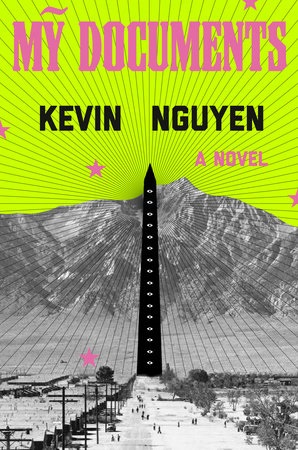 Book you're an evangelist for:
Book you're an evangelist for:
The Unnamed by Joshua Ferris. A very moving family story about the limits of what we'll sacrifice for our loved ones; it's also, structurally, very deft. I actually met the author once--he was quite rude--and I still throw this book at people. That's how accomplished it is.
Book you've bought for the cover:
I must be in an anti-cover mode right now because I've been picking a lot of books up from Fitzcarraldo Editions--their simple blue paperbacks suggest nothing, and I've liked going into a story completely cold.
Book you hid from your parents:
Honestly, I think my parents ask me more about what I'm reading now than when I was a kid. That said, I would absolutely never tell them about Tony Tulathimutte's brilliant and perverted story collection Rejection. Same for Halle Butler's mean and sly novel Banal Nightmare.
Book you most want to read again for the first time:
The Last Samurai by Helen DeWitt. A coming-of-age novel about language that almost feels foreign at first blush. (Although some of it is literally foreign.) It takes a bit of patience, since this book has to first teach you how life operates inside of it. I wish I could relearn that all over again.
Book your parents recommended to you:
From my dad, Thi Bui's graphic memoir The Best We Could Do; from my mom, Kazuo Ishiguro's contemporary classic Never Let Me Go.
Book that got you out of a reading funk:
Like a lot of people, I had a reading pause during the pandemic. (Sort of ironic, since I'd never had more time to sit around and read?) But Hilary Leichter's Temporary was the compelling and very funny debut novel that got me back into rhythm.
Book you wish was back in print:
Peter Earley and Gerald Shur's WITSEC, an extraordinary and revealing dive into the founding of the witness protection program. It reads like a thriller. Thankfully, used copies are plentiful.
Book that helped you understand this moment:
Kathleen Belew's Bring the War Home connects the end of the Vietnam War with the rise of white supremacy. I suspect a lot of people believe this political moment is particularly fraught--I agree--but there's some comfort in understanding how things got this way, and recognizing that it took five decades to arrive here.
Book Candy
Book Candy
Mental Floss found "12 things you say without realizing you're quoting poetry."
---
"James Joyce, with his eyesight failing, draws a sketch of Leopold Bloom (1926)." (via Open Culture)
---
Headline of the day, via the Guardian: " 'Funny, sexy and a bit weird': inside the new wave of literary parties."
---
Atlas Obscura embarked on "Titanic's legacy: our favorite reads."
Rediscover
Rediscover: Jane Gardam
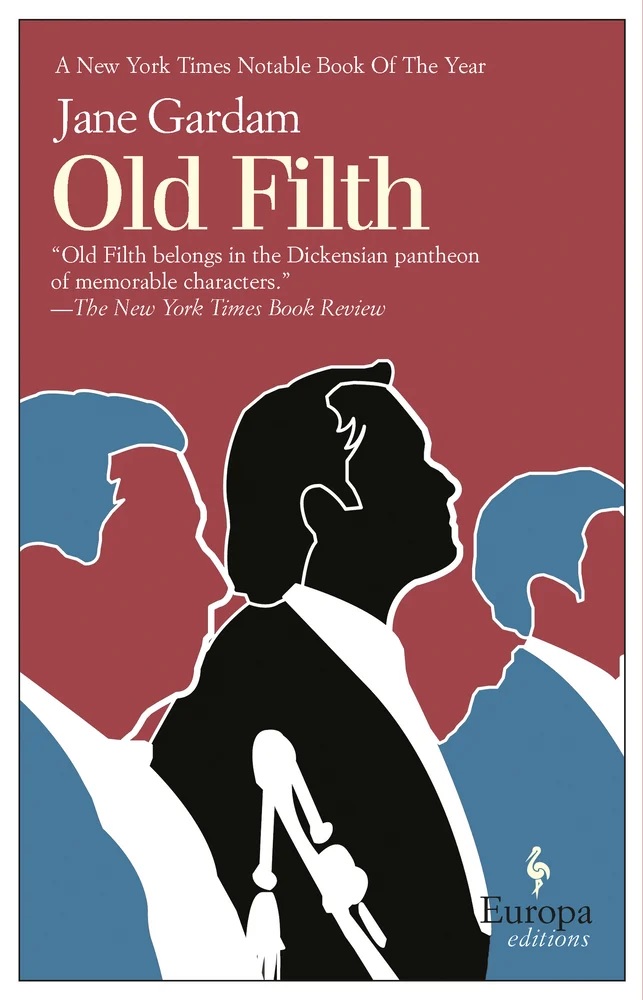 British author Jane Gardam, who "was regarded by many as the unsung heroine of English fiction... and won a formidable array of prizes," died April 28 at age 96. Gardam was perhaps best known for Old Filth (2004), which in a 2015 BBC survey was voted among the 100 greatest British novels. It featured a central character who reappeared in two follow-up novels, The Man in the Wooden Hat (2009) and Last Friends (2013).
British author Jane Gardam, who "was regarded by many as the unsung heroine of English fiction... and won a formidable array of prizes," died April 28 at age 96. Gardam was perhaps best known for Old Filth (2004), which in a 2015 BBC survey was voted among the 100 greatest British novels. It featured a central character who reappeared in two follow-up novels, The Man in the Wooden Hat (2009) and Last Friends (2013).
Although Gardam "never achieved the popular acclaim of contemporaries such as Margaret Drabble or Penelope Lively, she attracted a select army of admirers... Her strengths lay in an old-fashioned skill for storytelling, an instinctive feel for period and an ability to get under the skin of her characters. These qualities attracted a wide and faithful readership; she was never out of print and became one of the few literary novelists to make a respectable living out of fiction," the Telegraph wrote.
Gardam's The Hollow Land (1981) won the Whitbread Award (children's book category), and she took a second Whitbread for The Queen of the Tambourine (1991) in the adult category. God on the Rocks was shortlisted for the Booker Prize in 1978. Her other books include A Long Way from Verona (1971), Black Faces, White Faces (1975), The Sidmouth Letters (1980), The Pangs of Love (1983), Crusoe's Daughter (1986), Showing the Flag (1989), Going into a Dark House (1994), Faith Fox (1996), Missing the Midnight (1997), and The Flight of the Maidens (2000).
Diana Athill, reviewing Last Friends in the Daily Telegraph, praised the author's skill in turning a "very funny story... with no resort to sentimentality, into a keenly moving study of old age." Gardam, she noted, "could indeed write well about linoleum if she wanted to, but what she excels at is writing about the human heart and mind."
In 1999 she won the Heywood Hill literary prize for "a lifetime's contribution to our enjoyment of books," which prompted thoughts about her own mortality: "I have not perhaps given enough thought to stopping breathing," Gardam observed. "My will is more or less in order, though I am becoming sad that the bequests are getting fewer as friends drop from their perches and will never know I cared. I come from a very long-living family, all hypochondriacs but so enjoying their condition that they never seemed to grow old until they were suddenly gone."
She was one of the first novelists published by Abacus, an imprint of Little, Brown. The Guardian noted that Richard Beswick, her publisher, said she was "hugely loved by us all. Her warmth, humor and wisdom are quite irreplaceable."

